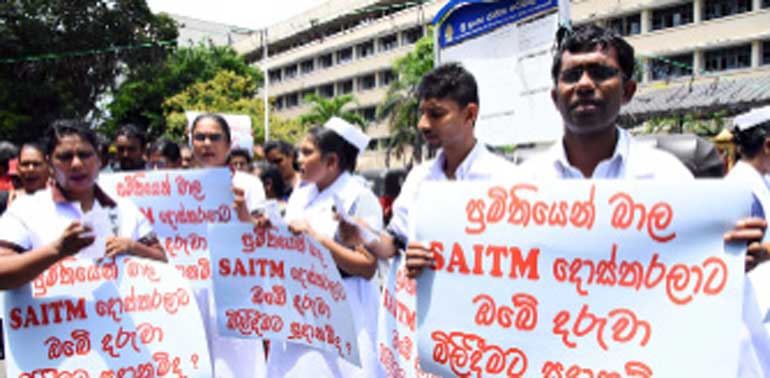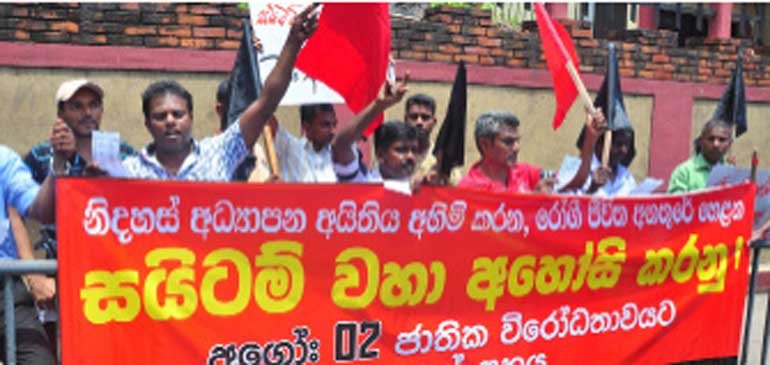Monday Apr 07, 2025
Monday Apr 07, 2025
Thursday, 3 August 2017 00:48 - - {{hitsCtrl.values.hits}}

 By Himal Kotelawala
By Himal Kotelawala
Parents of SAITM students yesterday expressed confidence that the Supreme Court will rule in favour of the controversial private medical college, allowing its graduates to receive provisional registration at the Sri Lanka Medical Council (SLMC), resolving the crisis once and for all.
At a media briefing held in Colombo, the Private Medical College Parents Society Ltd. (PMCPSL) called for a common examination for medical graduates from all state faculties, foreign universities and the South Asian Institute of Technology and Medicine (SAITM).
Attorney-at-law and PMCPSL President T.M.K.B. Tennakoon warned that while the Government has granted basic democratic freedoms to the public such as the right to protest, it would be a mistake to misconstrue it to mean that the Government is weak.
“There is a lot the Government can do. I believe it will take a firm decision,” he said, adding that both Health Minister Rajitha Senaratne and Higher Education Minister Lakshman Kiriella have made their positions clear. “We’re confident that once the Supreme Court decision is made, there will be a solution to this crisis and we will then see the difference between the quality of the 1,000 SAITM students and other doctors,” said Tennakoon.
The PMCPSL expects the Supreme Court to deliver its verdict either today or tomorrow, and anyone going against that decision, according to Tennakoon, will be held in contempt of court.
Tennakoon also alluded to a conspiracy hatched by a minority that included the GMOA and state medical faculty students manipulated by what he called ultra left parties to topple the Government, using the SAITM issue as a weapon. The press conference was also attended by SAITM Registrar Husni Hussain, who defended the recent Government takeover of the Neville Fernando Teaching Hospital (NFTH) as a move to provide much needed clinical training to its undergraduates. Responding to a question by Daily FT regarding allegations that the “donation” of the hospital might have been due to the heavy maintenance costs involved, Hussain said: “The current value of the NFTH is Rs. 3.55 billion. It’s a state-of-the-art hospital with modern facilities. This is what the chairman is donating; the brighter side of this, no one sees. Why do people see the negative things? How many of us would agree to donate something of this magnitude?”
Visiting Professor of Surgery at SAITM Prof. Neville Perera, who also spoke at the media briefing, said that the NFTH had over 3,000 OPD patients going through the hospital, but the anti-SAITM camp chose to cling onto the number of beds.
“To make a medical student, you don’t need SLMC approval,” said Prof. Perera, stating that the SLMC can only get involved when the question of internships arises.
Attorney-at-law and PMCPSL Secretary Anura Dhanaratna said that the SLMC only had the authority to test foreign educated students but not students of private medical colleges (PMCs) in Sri Lanka.
Serious allegations were levelled against the SLMC at the pro-SAITM event, with PMCPSL Treasurer Wimal Samarakoon raising questions about the statutory body’s conduct.
For 19 years, he said, the SLMC had recognised medical graduates from 238 foreign universities. By 2012 this number had come down to 174. Today, he said the SLMC website lists only 15 universities as officially recognised, with some 50 other international higher education institutes pending approval.
“It is unfortunate how the SLMC conducts itself as a state institute. They have admitted in their reports that [Sri Lankan] students coming from abroad are weak,” said Samarakoon, accusing the SLMC of helping organise courses for these graduates, going beyond the body’s mandate.
“These students are taught for three to six months; many institutes earn money from these courses,” he said.
“However, they have a different policy for SAITM students,” he added.
Samarakoon also said that in the medical council in the UK, only six out of its 12 members are doctors, whereas in Sri Lanka, all 24 members are from the medical profession. A majority of the professional doctors present in the SLMC are GMOA members, he said.
“It’s an institute that maintains the state monopoly. This is not suitable for a developed country or a developing country,” he said. Samarakoon also charged that it finds ways to introduce some graduates from universities not accepted by the SLMC into the medical profession through appeals. “There is no transparency,” he said. It’s not fair to say that SAITM graduates are of a lower standard than state medical faculty students, said Samarakoon, since the former have not yet been subject to a fair assessment.
“So the best solution is to test them, which is what we ask for. They don’t want this either because Government students may be worried that SAITM students may do better,” he said.
“We propose to amend the constituency of the SLMC and reinstate it as a body that’s appropriate for the country,” he added.
Pix by Sameera Wijesinghe
Discover Kapruka, the leading online shopping platform in Sri Lanka, where you can conveniently send Gifts and Flowers to your loved ones for any event including Valentine ’s Day. Explore a wide range of popular Shopping Categories on Kapruka, including Toys, Groceries, Electronics, Birthday Cakes, Fruits, Chocolates, Flower Bouquets, Clothing, Watches, Lingerie, Gift Sets and Jewellery. Also if you’re interested in selling with Kapruka, Partner Central by Kapruka is the best solution to start with. Moreover, through Kapruka Global Shop, you can also enjoy the convenience of purchasing products from renowned platforms like Amazon and eBay and have them delivered to Sri Lanka.
Discover Kapruka, the leading online shopping platform in Sri Lanka, where you can conveniently send Gifts and Flowers to your loved ones for any event including Valentine ’s Day. Explore a wide range of popular Shopping Categories on Kapruka, including Toys, Groceries, Electronics, Birthday Cakes, Fruits, Chocolates, Flower Bouquets, Clothing, Watches, Lingerie, Gift Sets and Jewellery. Also if you’re interested in selling with Kapruka, Partner Central by Kapruka is the best solution to start with. Moreover, through Kapruka Global Shop, you can also enjoy the convenience of purchasing products from renowned platforms like Amazon and eBay and have them delivered to Sri Lanka.